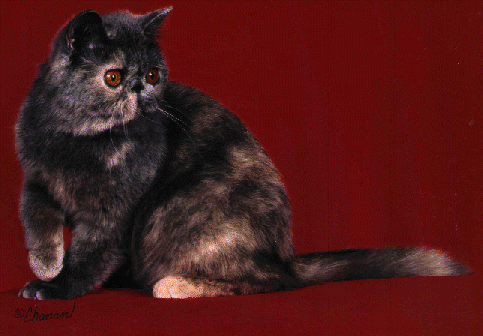
GRC Caliope April Showers 1993 CFA National Best Blue Cream
This FAQ has been compiled by the following exhibitors:
Patti Dailey, Daisen, Eugene Oregon, email:
pdailey@oregon.uoregon.edu
Claire Farmer, Revvilee Persians and Exotics,
Spokane Washington
Mary Lou Mills (Tacoma Wash)/Colleen Power
[California] Caliope Exotics,
email:
caliopecjp@aol.com
Copyright © 1995 Patti Dailey, Claire Farmer and Colleen Power, All Rights Reserved.
Exotic Shorthairs are wonderful shorthaired versions of the Persian. They have the flat faces of the Persian but a short plush teddy-bear look, and the usual small squeaky Persian voices. Very responsive to humans and human emotions, this breed has inherited their very tame personality and gentle ways from their Persian ancestry. However, twenty years ago, several shorthaired breeds were used as outcrosses to bring in the short coated gene, and as a result, Exotics are generally livelier and more inquisitive than Persians.
Showing the Exotic Shorthair has been called a "Persian wet tee-shirt contest." It is like showing a Persian in its underwear or sopping wet. The Exotic must meet the Persian standard with regard to nose, eye, ear, chin, and build. There is no long coat to be trimmed to hide ears that are too large, or set too high on the head. No massive ruff to hide a neck that is too long. No flowing coat to disguise those cats standing too tall or cowhocked. There are no great chops to be shaped to embellish a head that is too small or not round enough.
In the early 1960s, American Shorthair breeders began using Persians as outcrosses in an attempt to strengthen their type. However, the resulting kittens were unique and had a decidedly different appearance than they were looking for. This caused quite a furor between American Shorthair and Persian breeders in CFA. Finally, because the look was appealing, the breeders working with the hybrid lines decided to work on a new breed to be called the Exotic Shorthair. American Shorthair breeders were given a choice of registering the kittens as Americans or Exotics, but once registered as Exotics they could not return to American. In the mid-1960s, the core breeders expanded the program to include other shorthair breeds such as Burmese and British Shorthairs. In 1967 CFA gave formal recognition to the Exotic Shorthair as a breed. Among the early pioneers was Lion House Cattery, where top silvers and silver tabbies were produced from American Shorthair outcrosses. Another early pioneer was New Dawn Cattery, owned by ACFA judge Carolyn Bussey, who used Burmese as her shorthair outcross.
The large, round eyes set wide apart in a large round head contribute to the overall look and expression...
The thick plush coat softens the lines of the cat and accentuates the roundness...."
(100 point total) Head 30 points Body 25 points Head Type 10 points Boning 7.5 points Chin 5 points Shape/Size 7.5 points Nose Type 5 points Musculature 5 points Cheeks/Jowls 5 points Legs/Feet 5 points Ears 5 points Tail 5 points Eyes 10 points Coat/Color 20 points Shape/Size 5 points Coat 10 points Color 5 points Color 10 points Condition/Balance 10 points
Head (including size and shape of eyes; ear shape and set) .......30 Type(including shape, size, bone and length of tail)..............20 Coat..............................................................10 Balance............................................................5 Refinement.........................................................5 Color.............................................................20 Eye Color.........................................................10
Below are examples of the many colors you can find in exotic shorthairs:
(Click on the cat's name to see the photo.)
Exotic Shorthaired Kittens range in price from ($350-$1000) for an altered kitten. Breeding or Show kittens range in price from $800-$3500, depending upon the bloodlines and show expectations.
With much thanks to Marie Lamb for her help in establishing this FAQ.
Breeders of all breeds of cats may be found through the Fanciers breeder listing page
HTML by Laura Gilbreath updated 29 August 1995